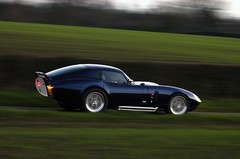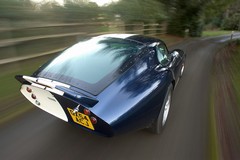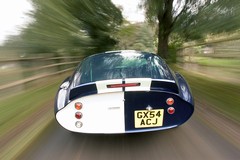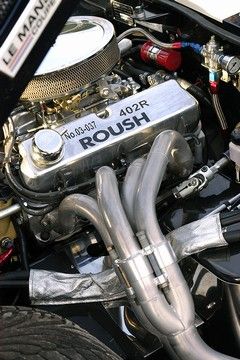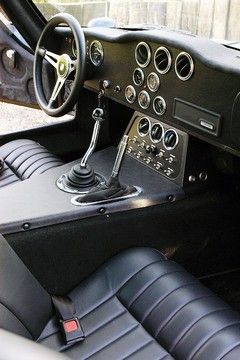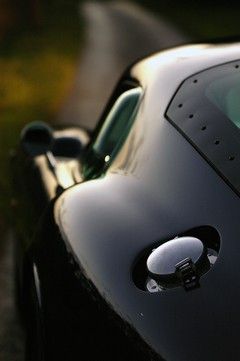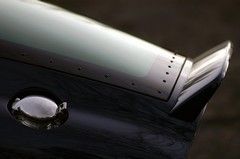Superformance Le Mans Coupé
Nick Hall reports on a fire-breathing, 6.6-litre 510bhp monster
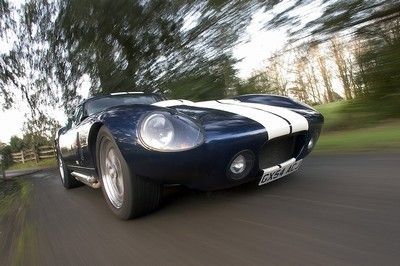
Superformance Brock Daytona Coupé
Imagine, for a second, that da Vinci had the chance to repaint the Mona Lisa 40 years after the event. Maybe he'd change the light, or perhaps he'd have cheered up the model and the most famous frown on Earth would now be a smile. The simple fact is that, with the benefit of hindsight, new materials and a fresh chance, he would have done a better job. Even a masterpiece has room for improvement.
|
A BITE OF HISTORY The original 380bhp Daytona Coupé was born from the Shelby 289 Roadster that was all-conquering on American road courses with short straights and low average speeds. On the faster European tracks, though, it was demolished time and again by Ferrari. It's ironic, then, that Enzo Ferrari's desire to tamper with the rules eventually led to his own demise. Ferrari's snub-nosed 250 GT Berlinetta had reached its aerodynamic limits in the early '60s and, refusing to build 100 examples of a new car simply to homologate a new winner, Enzo Ferrari lobbied for a change in the rules that said manufacturers could change the body of an existing model. It was meant to accommodate tweaks, but the rules of motor racing are often vague and Ferrari used it to drop the GTO body on the Berlinetta chassis. He must have worn a smug smile that day, but it didn't last long. Brock used the same loophole to design a radical new body for the 289 chassis based on a physics paper he had read some 30 years previously. Even Caroll Shelby doubted the savage, chopped rear end would work with his 4.727-litre engined chassis, but when the car tested for the first time on 1 February 1964 at the Riverside Circuit, it smashed the 289's lap record by 3.5s. After testing, the team had just three weeks to prepare for the Coupé's competitive debut at Daytona, where it led the GT field by five laps until a pit-fire ruined its race. In less than a month a legend was born. Class of the field There was no stopping it after that. The Coupé won its class at Le Mans and would have won the World GT Championship in its debut season, had Ferrari not pulled some strings and made Monza cancel the final round to give him the crown. It was a hollow victory and, when Ferrari announced he would not run a factory GT team in 1965, everybody knew he had been scared out of the competition by this stunning new creation. Privateer Alan Mann ran the Cobras in 1965 as Ford and Shelby switched their attention to the GT40 development, and he swept the board in the World GT Championship. His driver Jack Sears was also partly responsible for the 70mph speed limit coming in to the UK after clocking up 185mph on England's main motorway during a test run. It was an aerodynamic revelation with a drag coefficient of 0.29, which could rival most of today's sportscars, as could its time of 4.4s to 60mph. But the introduction of the GT40 spelt its competitive end -it was in the Shelby's contract with Ford that they would not compete with the manufacturer's new toy – which spells out just how worried everyone was about this car. Only six Daytona Coupés were ever built, and at the end of '65 Mann sold them in Los Angeles for a few thousand dollars each to avoid a huge tax bill. Now they go for upwards of $4 million at auction, which makes that about the dumbest decision he ever made. |
Peter Brock's AC Shelby Cobra Daytona Coupé was the automotive equivalent of the artist's best work. Now, 40 years after the original blew Ferrari off the road in the GT Championship, Brock got a second chance with the Superformance Brock Daytona Coupé. And while it may look like the classic Coupé on the outside, the similarity really is just skin deep. This is a modern supercar with power figures that compare to the likes of the Porsche Carrera GT and Ferrari Enzo, but costs a fraction of the price and has a ready-made heritage.
Second time around
There have been a number of replicas on the kit-car market over the years, but most weren't worth the scrap metal they were made from. Jim Price, the man behind the factory that builds the awe-inspiring Noble body in South Africa, was determined to bring the Daytona back at full strength, though.
There was one big condition, if Brock wouldn't design it the project would go no further. He took some persuading after their initial conversation in 1996, but when Price agreed to take on Bob Negstadt – the designer of the Cobra 427 chassis – Brock shook hands on the deal.
Neither Brock and Negstadt were happy with their most famous creations, constrained as they were by time and budgets in both cases. The Daytona Coupé also had to build on the 427 chassis, which was the wrong size, had leaf spring suspension and was well out of date even in the 60s. The Coupé won despite of, not because of, its mechanical underpinnings. Given a second chance, they went back to the drawing board.
Motivation
Generally engines have downsized over the years as we've figured out how to drag more horses from smaller capacities, but lift the long composite plastic bonnet on the Coupé and an epic 6.6-litre, 510bhp Roush Racing-prepared Ford V8 crowned with a massive carburettor stares right back. This unit has 130bhp more than the fearsome racing Cobra, but the car has real seats, an interior and a solid tubular steel chassis, so it has 1,300Kg to send squirming down the road.
It's similar to a NASCAR engine, only much bigger, and the guttural roar on start-up startled the surrounding trees. With the composite hood up you can actually see the engine gulping jets of fuel, it's an awe-inspiring sight indeed.
This version had false side exits on the exhaust and a silencer box underneath, but some customers go for the full bore effect and the burst eardrums.
But in the real world...
In truth, the V8 doesn't work too well at town driving speeds. Below 2,000rpm it splutters as it desperately drinks fuel, while the gas pedal and engine feel like entirely separate entities as the big V8 is slow to react.
Above 2,000rpm, though, when this car's engine starts to breathe free, the Superformance takes off with all the violence of a Great White Shark in full attack mode and even though I had the big and surprisingly light wheel in my hands and the fighter jet-style instrument layout in my sight, I still felt like a passenger.
UK importer Nigel Hulme has created a new inlet system with Roush that will strip 30 horsepower from the headline figures, but make it a more useable weapon at the low end. It certainly won't miss those extra ponies.
The Superformance hits 60mph in 3.9s, 100mph in 8.6s and will take the quarter-mile in 11.5s. The maximum speed of this monster has been independently tested at more than 200mph and one car in South Africa has been clocked at 207mph.
It's simply ferocious, but a little gel-filled limited slip differential on the rear axle stops either wheel spinning much faster and sending the tail out into an unstoppable slide in a straight line – an occupational hazard with the original.
Of course it's possible to unstick the rear wheels in corners, but you've really got to be going after hooligan thrills. And the Coupé's rugged chassis design ensures the car doesn't flex mid-corner, keeping a slide progressive and manageable.
Underpinnings
The Superformance is 6cm longer than the original Coupe.
That's how long Negstadt wanted the 427 before AC cars presented him with pre-cut tubes and told him to make do.
Independent A-frame wishbone suspension all round with Bilstein shock absorbers developed specifically for this car combine with the differential to provide handling that could rival supercars from the superpowers today.
The vacuum-boosted brakes, with Australian PBR callipers clamping down on 12.8-inch vented discs in the front and 12-inch discs in the back, are a little savage when the car is cold, but with some heat in them they sensitise and soften up just enough.
Let's face it, with this much power it helps to have sturdy anchors in any case and everything in the Superformance is built with rugged durability and simple effectiveness in mind. It's not a thoroughbred European motor, it's an honest, blue-collar, old-fashioned racer for the road.
Built for luxury
While the original was a pure racer, where searing heat in the cabin and discomfort went with the territory, this is an expensive road car that has to keep its well-heeled driver comfortable. The leather and Alcantara interior, therefore, has as many creature comforts as possible and only the styling is from the old world. It's a superbly impressive machine in turnkey form, with the finish going well beyond the standards of a kit car manufacturer.
Of course it's still hot in there: a 6.6-litre engine is never going to be cool, but Price and Brock expended great time and effort to keep the heat from the cabin. This car is also fitted with air-conditioning and other items that the racers must have dreamed of half-way through the Le Mans 24 Heures.
There are a number of other Cobra replica manufacturers out there, but this one clearly had Carroll Shelby worried. He went to the trouble of pulling legal strings and getting the first one on US soil impounded after claiming copyright infringements, but now its here and proudly bears both Brock's name and the Daytona moniker that it adopted decades ago.
The Superformance Coupe is a thoroughly modern supercar, well worth its sub-£80,000 price tag and that spiritual link to the Cobra. It was Brock and Negstadt's second chance to build a masterpiece under the snake's skin, and it would even make Mona Lisa smile.
Photos by Paul Harmer
Gassing Station | General Gassing | Top of Page | What's New | My Stuff

